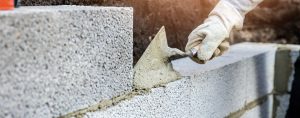In the world of construction, there’s a crucial, albeit often understated, component that holds everything together – mortar. In this blog post, we’ll explore the world of mortar, answering questions like “What is Mortar?” and “Why is Mortar important to use?” We’ll also dive into the various uses that make it an indispensable part of the construction process.
What is Mortar?

Mortar is essentially a blend of water, sand, and cement (or lime), meticulously mixed to create a paste-like substance. It may appear unassuming, but it’s the magic adhesive that binds bricks, stones, or other building materials together. This paste hardens over time, forming a solid, stable structure that can endure the test of time. What makes mortar fascinating is its adaptability. Different projects require different types of mortar, tailored to specific needs, such as load-bearing capacity, climate resistance, or even architectural preferences.
Why is Mortar Important to Use?

Structural Integrity:
At its core, mortar provides the much-needed structural support. It evenly distributes the load across the surface, preventing individual bricks or stones from shifting or collapsing. It’s the silent strength that underpins every solid structure.
Weather Resistance:
Mortar acts as a shield against the harsh elements. It’s your building’s armour against rain, wind, and temperature fluctuations. Without mortar, erosion would soon take its toll, compromising the long-term durability of your structure.
Aesthetic Appeal:
Mortar isn’t just about strength; it’s also about style. The colour, texture, and type of mortar used can significantly influence a building’s visual appeal. It’s a key player in the aesthetics game.
Flexibility:
Mortar is designed to accommodate minor shifts in the building. This flexibility helps prevent cracks and ensures that the structure remains intact even in earthquake-prone regions.
The Uses of Mortar

Bricklaying:
Mortar is the adhesive that firmly bonds bricks, forming robust, enduring walls. Beyond bonding, it provides structural stability, ensuring secure placement of bricks. It transforms a stack of bricks into a resilient, load-bearing wall, standing strong against time and the elements.
Stone Masonry:
In stone masonry, mortar unites stones, creating sturdy, visually appealing walls and facades. It offers both structural support and artistic potential. Mortar empowers stonemasons to weave creativity and artistry into each structure, merging strength and beauty.
Tile Installation:
Mortar serves as an invisible adhesive force, securing tiles on floors, walls, and ceilings. Its strong adhesive properties guarantee durability, even in high-traffic areas. Mortar is the key to achieving beautifully tiled spaces, whether it’s a warm kitchen floor or an elegant bathroom wall.
Repointing:
Over time, weather can erode mortar joints in brickwork. Repointing uses mortar to repair and replace eroded or damaged joints, restoring structural integrity and appearance. Older buildings regain their historic charm and strength, thanks to the rejuvenating touch of repointing with mortar.
Plastering:
Mortar’s versatility extends indoors, creating smooth, paint-ready surfaces on walls and ceilings. It forms a seamless canvas for artistic expression and design, enhancing the aesthetic appeal of interior spaces. Mortar turns plain walls into opportunities for creativity, making living spaces vibrant and welcoming.
Conclusion:
In essence, mortar is the unifying force in the diverse world of construction. Whether binding bricks, stones, or tiles, repairing the aging joints of historic structures, or creating a flawless surface for paint, mortar is the reliable partner that ensures the durability and visual appeal of a wide range of projects. It’s not just a building material; it’s the quiet architect behind the scenes, shaping the landscapes of our built environment.
Ready to fortify your Manchester property? Contact our team at Paramount Pointing & Restoration for expert Mortar Pointing, Damp Proofing, and Brickwork. Let’s build and protect together.


